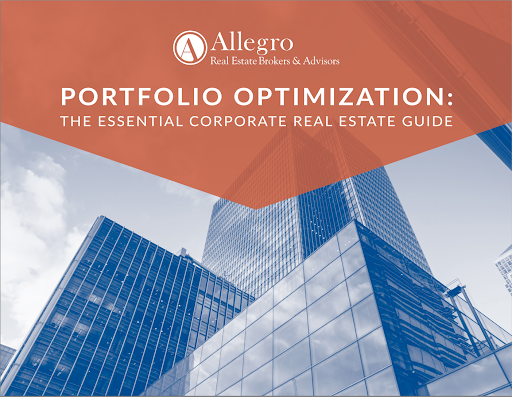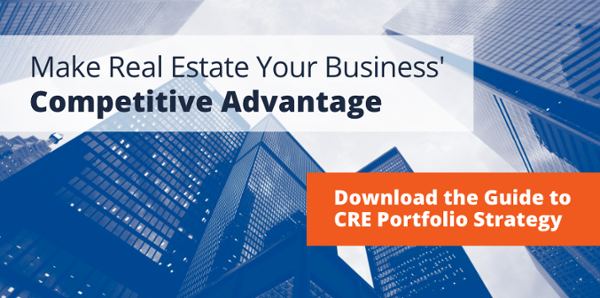Developing your corporate real estate strategy is a long-term play that will help to grow and enhance your business objectives for years to come. It’s important to note that when it comes to developing your real estate strategy, there’s so much more to consider than just the physical building or space.
A thorough corporate real estate strategy takes into account the importance of the people, the processes, and even the various technologies that will influence your portfolio.
Keep reading to learn why each factor plays an integral part in your long-term goals.
People
Employees
Your employees are the core of your organization and should have a heavy influence on your corporate real estate strategy. Consider how your physical location will impact your employee’s daily lives—are there amenities nearby for them to take advantage of? What will their daily commute look like?
Now think about how your physical location will impact your attractiveness for fresh talent and how it may even affect retention. Recruiting is already a difficult task, and when you consider that the average cost of replacing employees is about 20% of their annual salary, you start to realize the impact your space can have on financial and talent goals. To help alleviate some of these concerns that come with recruiting and hiring, consider how your space will effectively serve as an attractor for talent acquisition. The key is to offer accessible, flexible, and engaging work environments.
Stakeholders
Next, consider accessibility to your partners, customers, and suppliers. What locations will help to enhance your relationship with these stakeholders? Depending on your business, the location might have little to no impact on your services, but it’s a key factor to consider when you think about the “people” part of your commercial real estate strategy.
Also, consider, is the real estate functionally supportive to stakeholders and customers? Function is multifaceted but generally refers to how accretive the bricks and mortar are to the customer experience and complementary to the procurement of goods and services. When buildings do not support this transaction a new strategy is needed.
Internal Decision-Makers
Lastly, ask yourself who within your organization will be taking care of the real estate. Who are the major decision-makers? Who will be setting and approving real estate budgets? Of the necessary tasks involved with a real estate acquisition, which should you outsource to a professional team?
For larger enterprises, this team might be, for the most part, internal with the exception of certain tasks being outasked. Out-tasking is when one or two functions of the real estate process are completed by a third-party firm. For small to medium-sized businesses, you might outsource those services, meaning you’ll enlist the help of an entire external team to help you throughout the process. In both scenarios, you may also consider project-based procurement, which entails one-off services on a project-by-project basis.
Whatever your unique needs are, Allegro can be that team of experts, or offer individual consulting services to larger enterprises to help guide your strategy.
Processes
Real Estate Processes
The real estate processes involved in building a corporate real estate strategy include transactions, design and construction, and facilities management. Each of these is essential to a successful acquisition and effective real estate strategy. Who manages the transactions? Who leads design initiatives for your organization, and what about the actual construction of it? And lastly, who handles the facilities management processes? Having a standardized approach to these processes will only benefit you in the long run. Some of these functions can be handled by internal staff, others can be performed by external professionals or a combination of both. The pros and cons of these approaches should be vetted properly.
Business Processes
Business processes typically involve factors like lease administration, accounts receivable, accounts payable, and job cost accounting. While these may not be the first processes you consider when planning your overall business and real estate strategies, they are vital to your success. To effectively execute your strategy, consider how each of these functions will be completed and who is responsible for them. The larger your real estate portfolio grows, the more critical these issues become.
Technologies
In terms of your real estate strategy, when we discuss technology, we’re referring to integrated real estate systems. That includes things like lease management, space management (think CAD and CAFM), facility management and project management/collaboration tools.
There are hundreds of programs that fall into each of those three categories listed above, but what technology will work best for you depends on your organization and internal processes.
Our experienced team at Allegro works with corporations and organizations to sort through these technologies and programs to identify the best solution for their unique needs. If you’re interested in being proactive with your organization’s approach to real estate, speak with one of our real estate professionals today.
Discover the benefits of a strong CRE strategy.
To learn how it supports overall business strategy, download our free guide, Corporate Real Estate Portfolio Strategy: Your Business’ Competitive Advantage.








